Last updated February 2020 | Words and photos by Vietnam Coracle | 29 comments
This post was last updated 5 years ago. Please check the comments section for possible updates, or read more on my Updates & Accuracy page.
INTRODUCTION | GUIDE | MAP | RELATED POSTS
Wild camping in the pine forests of the Central Highlands, which spread in all directions over the mountains around Dalat, is one of my most memorable travel experiences in this part of Vietnam. As much as I like the city of Dalat, it’s the surrounding landscape that most appeals to me whenever I make the journey up to this area of the Central Highlands: purple mountains cloaked in pine forests stretching into the misty distance; the smell of wood smoke and coffee blossom scenting the cool air; the stillness and silence of an alpine landscape most people wouldn’t normally associate with tropical Vietnam. For me, by far the most rewarding way to experience this region is by camping independently in the pine forests north of Dalat. On this page, I’ve compiled an introductory guide to how to camp in Dalat.
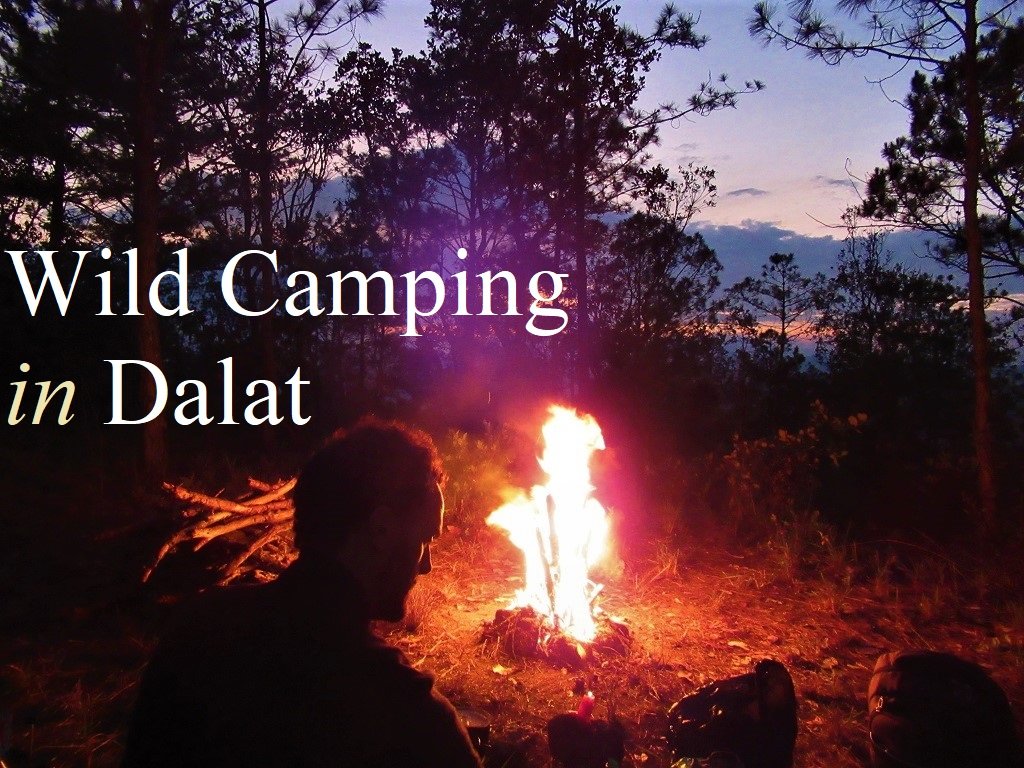
Camping in the pine forests north of Dalat is the most rewarding travel experience in the region
[Back Top]
GUIDE: CAMPING IN DALAT
Wild camping in the pine forests around Dalat is extremely good fun. In fact, if you do it right, camping in Dalat may turn out to be one the best experiences of your entire Vietnam trip. However, independent wild camping requires preparation, common sense and responsible behaviour. Below I’ve covered several topics, such as where to camp, what equipment to bring, weather, and safety. Click an item from the contents below to read more about it:
CAMPING MAP:
Camping in the Pine Forests North of Dalat
- Blue lines: paved roads
- Red lines: dirt roads & tracks
- Green zone: pine forests & potential campsites
View in a LARGER MAP
Why Camp in Dalat?
For me, camping in the pine forests is unquestionably the best travel experience you can have when visiting the Dalat region.
The first time I came to Dalat, in 2005, I remember my excitement building on the bus journey as the road climbed higher through jungle and mountains, only to be disappointed on arrival, when I realized that very little of this landscape is actually visible from the city itself. What was the point, I wondered, in travelling all the way up into the mountains if, once you arrived, there wasn’t really much sensation of being there? Of course, most visitors to Dalat go on excursions to waterfalls, lakes, coffee farms, and valleys within easy reach of the city. However, because Dalat is such a popular destination – for domestic and foreign tourists alike – these nearby scenic sites are often (but not always) heavily commercialized, busy and underwhelming. By far the best way to really immerse yourself in the natural setting of this area, is to rent some wheels, ride a fairly short way north out of the city, find a spot in the pine forests, and camp.
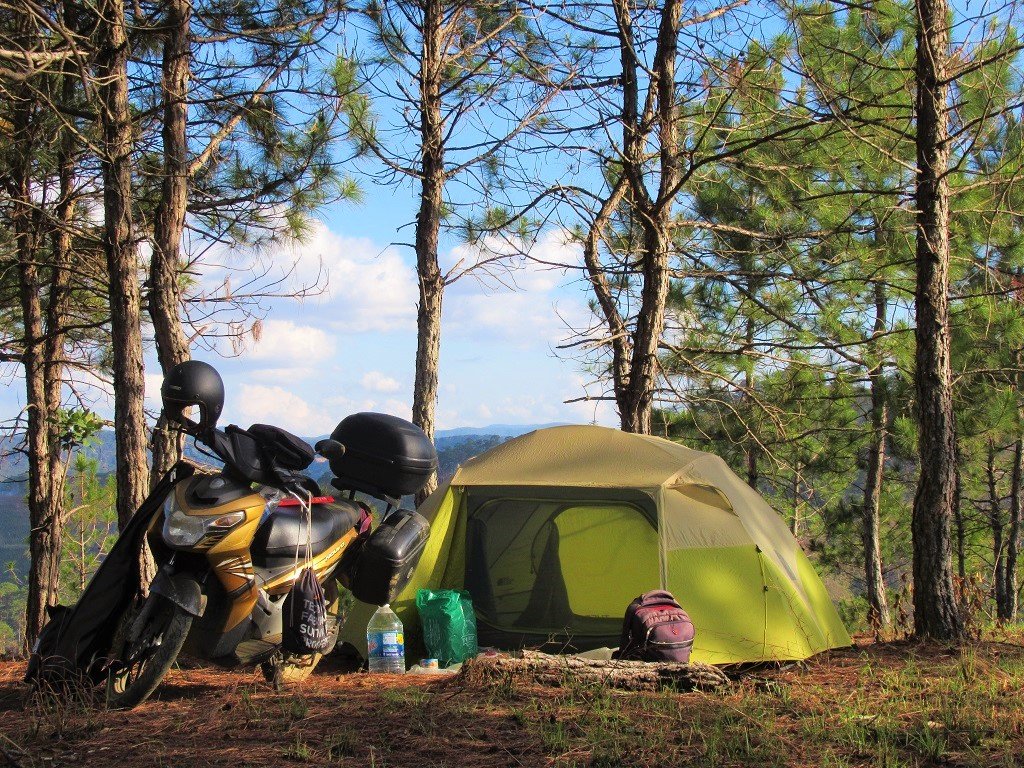
Ride out of Dalat city & into the mountains & forests
Whether camping alone or with friends, chances are that sleeping out in the forests north of Dalat will be a night (or more) that you’ll remember. Indeed, I’ve been travelling around Vietnam for over a decade, and my camping trips to Dalat are among my most memorable travel experiences. If you find a good campsite by late morning, you can spend the day in the dappled sunlight beneath the canopy of giant pine trees, watching the colours change over the mountains, chatting, reading, snacking, playing the guitar and singing until sunset. I usually make a fire at dusk as the sun is disappearing behind the ridges to the west. When darkness falls it’s often a surprise to find that mine is not the only fire in these forests: other flickering orange lights may appear in the landscape around – a reminder that some people in the Central Highlands still live semi-nomadic lives.
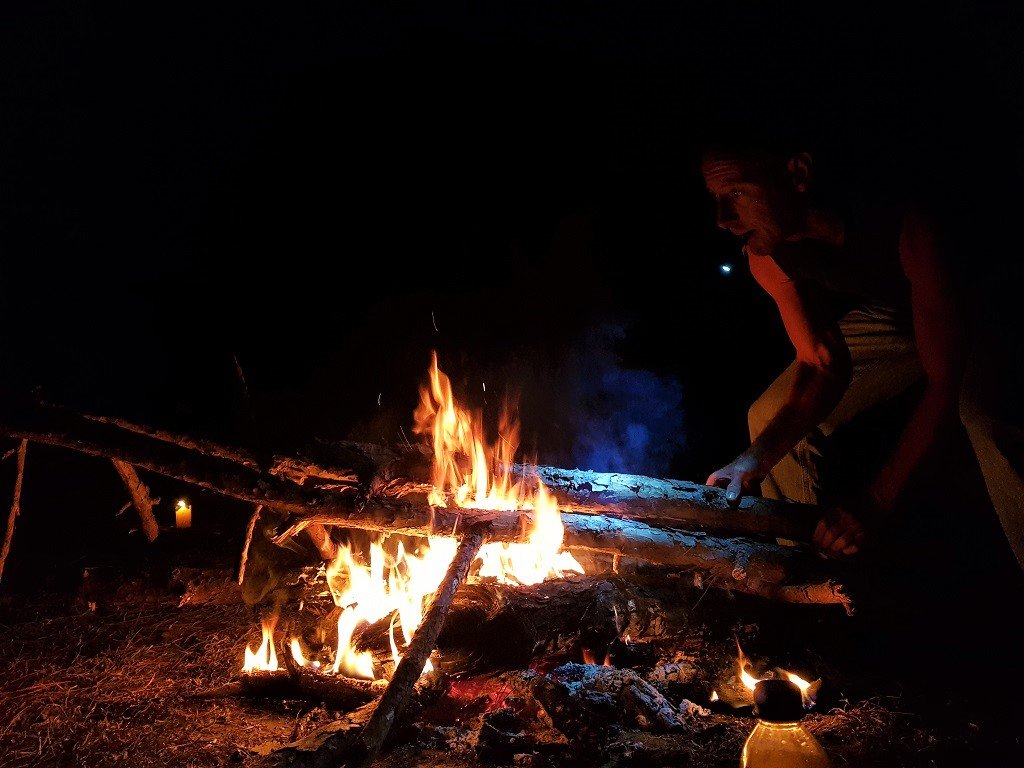
Wild camping in the pine forests north of Dalat is a memorable experience
When the night gets cold I lie by the fire, watching the stars and thinking about the animals that once inhabited these forests: travel writers in the 1950s wrote about wild tigers and elephants being a daily concern for locals, who avoided walking from house to house in Dalat at night for fear of animal attack. Today, however, the only large wildlife you’re likely to encounter are cattle (which can still be a pretty scary sight in the middle of the night). The things that stay with me the most from my camping trips in Dalat are the sound of the wind through the pine trees at night – a sound that is at once haunting and comforting – and the crisp, cold dawns, with the grey mist hanging in the valleys lit red from below by the rising sun. But, more than anything else, it’s all the good times I’ve spent out in this landscape, in the fresh, open air with my close friends, staring up at the stars and drinking rice wine together, talking, laughing, and falling asleep on the mountainside as the embers of our campfire glow in the darkness.
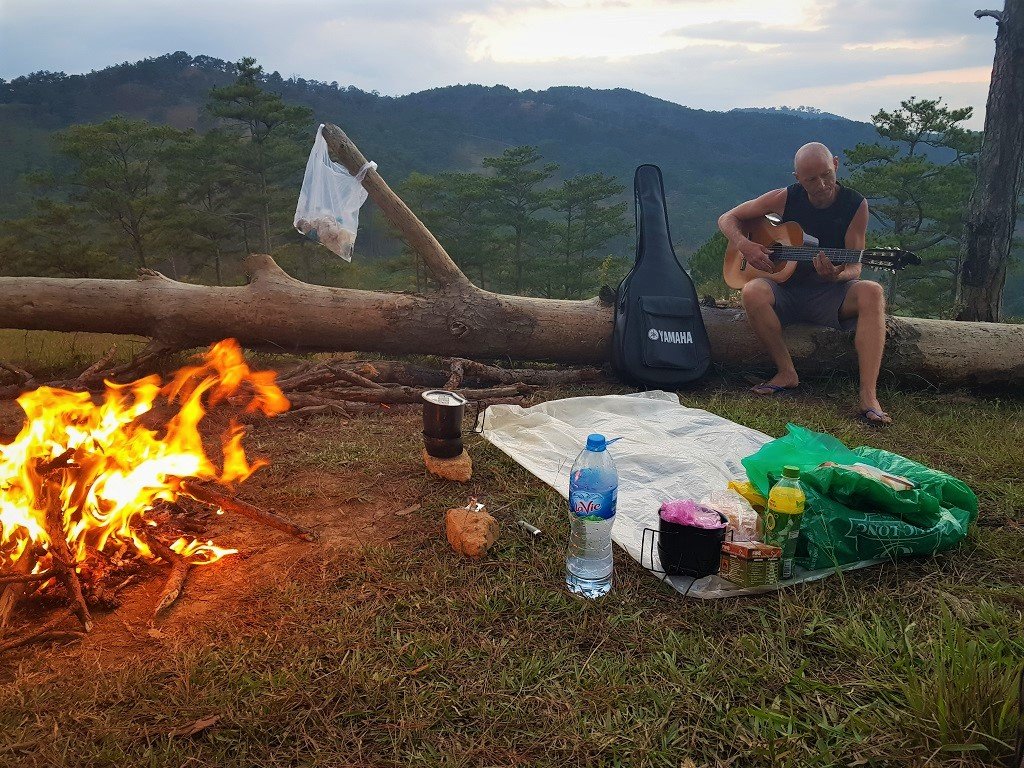
Over the last 10 years I’ve camped in Dalat dozens of times; sometimes with friends, sometimes alone
Where to Camp & How to Choose a Campsite?
Finding a good campsite is part of the fun of camping in the forests north of Dalat. Take your time (try to leave Dalat in the morning to give yourself several hours to ride around before choosing a suitable site), and think carefully about what it is you’re looking for. To get to the pine forests you’ll need a motorbike or bicycle which, if you don’t have one already, you can rent in Dalat. Ride due northwest out of the city, heading towards Hồ Suối Vàng (Golden Spring Lake), a popular attraction and picnic spot for domestic tourists. It’s a relatively short and pleasant ride, taking around 30-45 minutes on good roads (see my map). Before reaching Ho Suoi Vang, the road splits: here you can bear right for the lake and the Pine Tree Road (DT722), which is an excellent asphalt road stretching for another 40 kilometres due north before dead-ending near the village of Dung K’Nor, but en route there are lots of potential campsites in the forests and hills, accessed via dirt roads leading off the main road (see my map); or you can bear left towards Pang Tieng and Da Nghit villages, both of which are at the beginning of amazing networks of dirt roads leading into the mountains and through the pine forests after crossing the river to the west. Either of these options should reveal countless opportunities for campsites.

The pine forests north of Dalat are easily accessible & perfect for camping
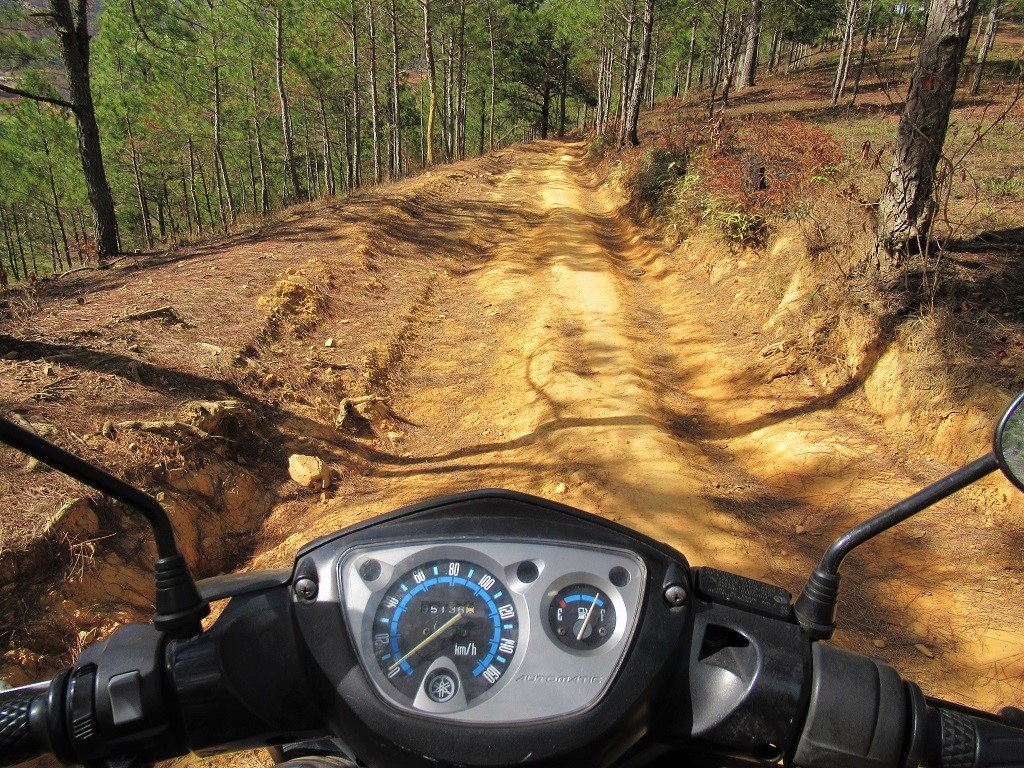
A large network of dirt tracks lead off the main roads & deep into the pine forests & mountains
Of course, the further off the main road you go, and the further down the dirt roads you go, the more isolated, peaceful and beautiful the potential campsites become. The last time I camped in this area, I spent days riding more than a hundred kilometres of dirt tracks through the pines; ridge after ridge, stretching into the distance. However, if conditions are wet, these dirt tracks can be extremely muddy, slippery and treacherous: only go when the weather is dry, and even then remember to ride very carefully (see Weather).

The further you go, the more isolated, peaceful & beautiful it becomes
Ideally, I like to find my campsite by late morning so that I can pitch my tent, collect fire wood and organize my things, then enjoy the rest of the day, whether by myself or with my friends. The pine forests here are perfect for camping: the carpet of fallen pine needles is soft to sit and lie on, the pine trees offer shade from the sunshine during the day and shelter from the cold, wind and rain during the night, and there’s plenty of dead wood lying around for making a small fire (although obviously you need to be extremely careful, especially in the dry season, because pine is very flammable). The idea is to leave your campsite exactly as you found it: take a before and after photo if you like; they should look the same. That means taking you trash away with you and making sure you extinguish your fire properly before you leave. Use your common sense and don’t leave anything to chance. Wild camping requires you to be sensible, careful and responsible, otherwise things can go badly wrong.
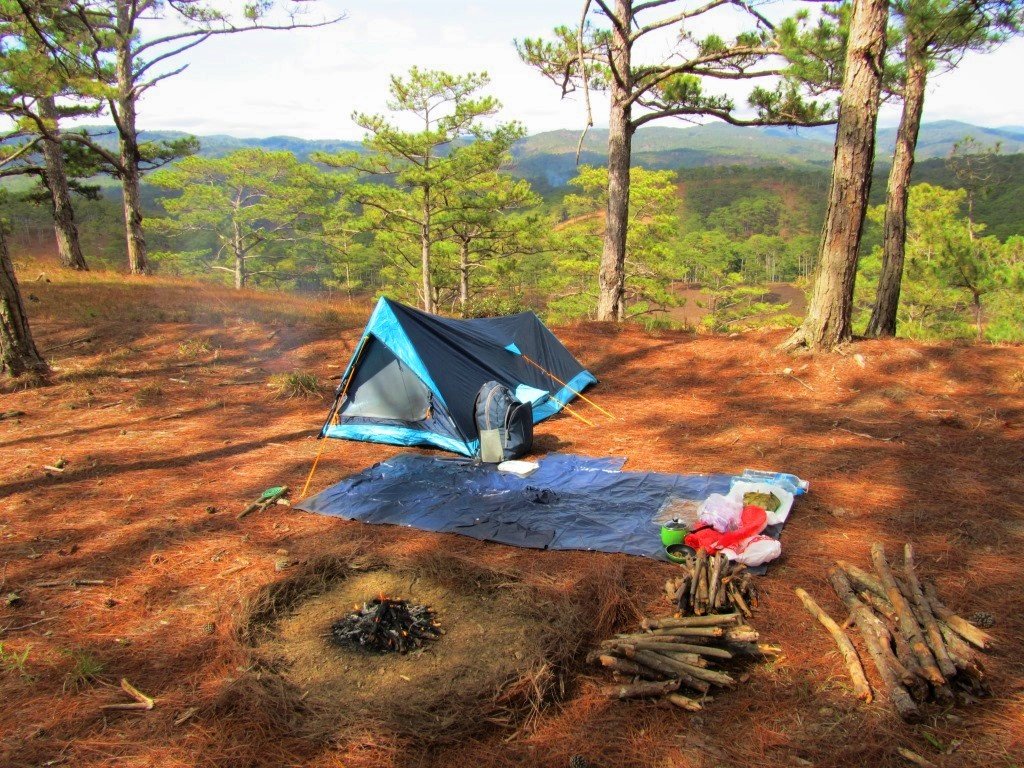
Spend some time trying to find the ‘perfect’ campsite & think carefully before deciding on one
Choose your campsite carefully. I can get a little obsessed with finding the ‘perfect’ site: a grassy patch of land on a mountaintop surrounded be a copse of beautiful pines, with panoramic views over the endless forests and ridges, and no one about. And, indeed, it is possible to find just a site as this, if you’re willing to spend the time and effort searching for it. Generally, however, a good campsite in this particular region is one with a clear path to the main road (in case you need to make a quick exit because of bad weather or any other unforeseen circumstance during the night), but preferably not in sight of it. This is because you don’t want to attract the curiosity of any passersby. As a general rule, try not to draw attention to yourself: wild camping is still quite unusual in Vietnam, so anyone who sees a traveller setting up their tent in the middle of the woods will naturally be curious, or even, in some cases, suspicious. Try to make sure no one sees you riding into the forests from the main road, and make sure you choose a campsite that is both in a commanding position – where you can view your immediate surrounds – but also relatively hidden from view.
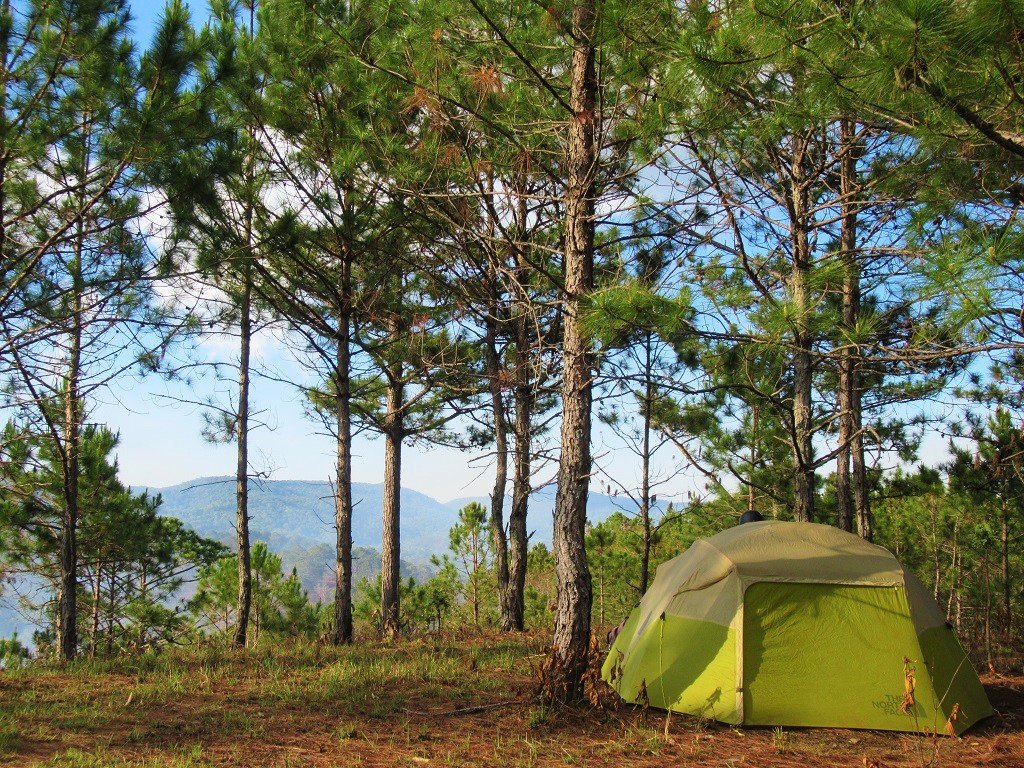
A good campsite should be in a commanding position but also relatively hidden from view
Bear in mind that, at this altitude (over 1,500m), the nights can be surprisingly cold. Don’t pitch your tent in a position exposed to the prevailing wind, but also remember that, if it rains during the night, you don’t want to be at the bottom of a slope where all the runoff rainwater will flood your campsite. Shade should be another consideration, especially for the daytime, because when the sun is up and the night’s chill has gone, the days can get very hot, very quickly. Most importantly, in my opinion, is to find a campsite with a view: one of the most enchanting and memorable parts of camping in these pine forests is watching the sunset and the sunrise.
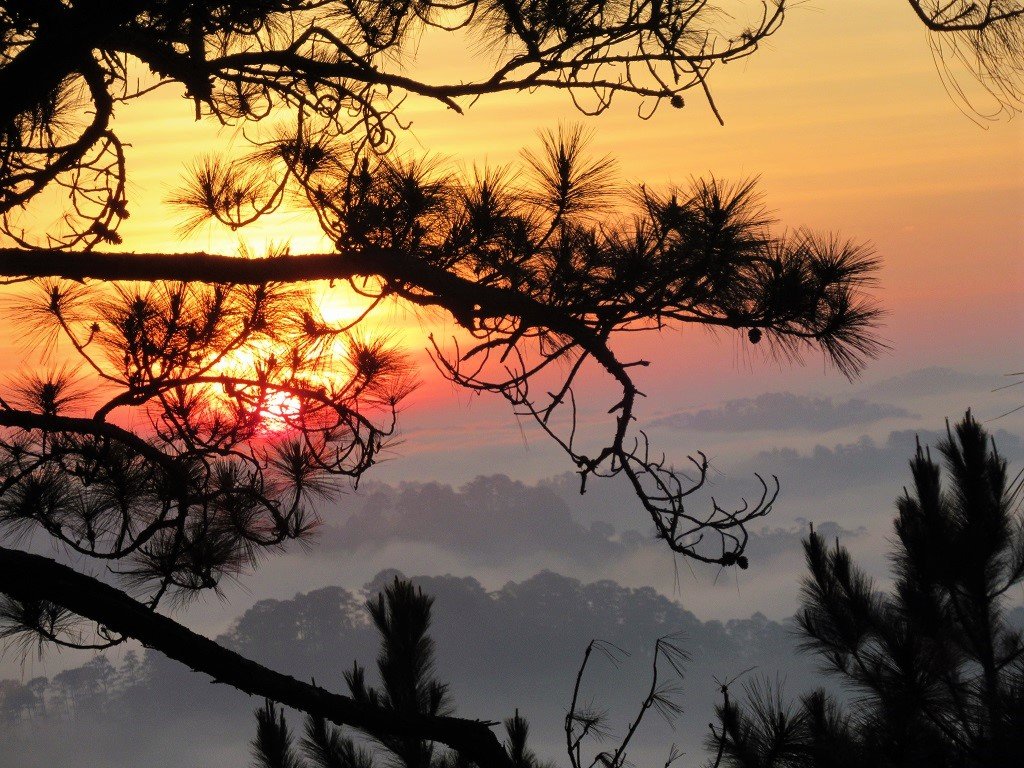
Above all, make sure you choose a campsite with a fabulous view from your tent
What Equipment do I Need & Where to Get it?
Make sure you come prepared. This is ‘wild camping’, so it’s up to you to take responsibility for yourself and do everything you can to make sure the experience goes smoothly. Firstly, you’ll need a tent. I bought mine years ago in a camping store in Covent Garden, London. But there are now quite a few camping shops in Saigon (Ho Chi Minh City) and most other major cities in Vietnam that sell decent tents. Camping is becoming more and more popular in Vietnam, especially among young independent travellers, so there are more and more shops selling camping equipment. In Saigon, Danang and Hanoi, FanFan is a good place to start. But you can find other camping stores by googling and asking around wherever you are. In Vietnamese useful phrases are: đồ cắm trại (camping equipment), đồ dã ngoại (outdoor gear), cái lều (tent). In some popular tourist destinations, such as Dalat, it should also be possible to find somewhere to rent a tent and other camping equipment. Although I can’t recommend any particular places in Dalat to rent or buy camping gear, it shouldn’t take too much digging to be able to find out about it.
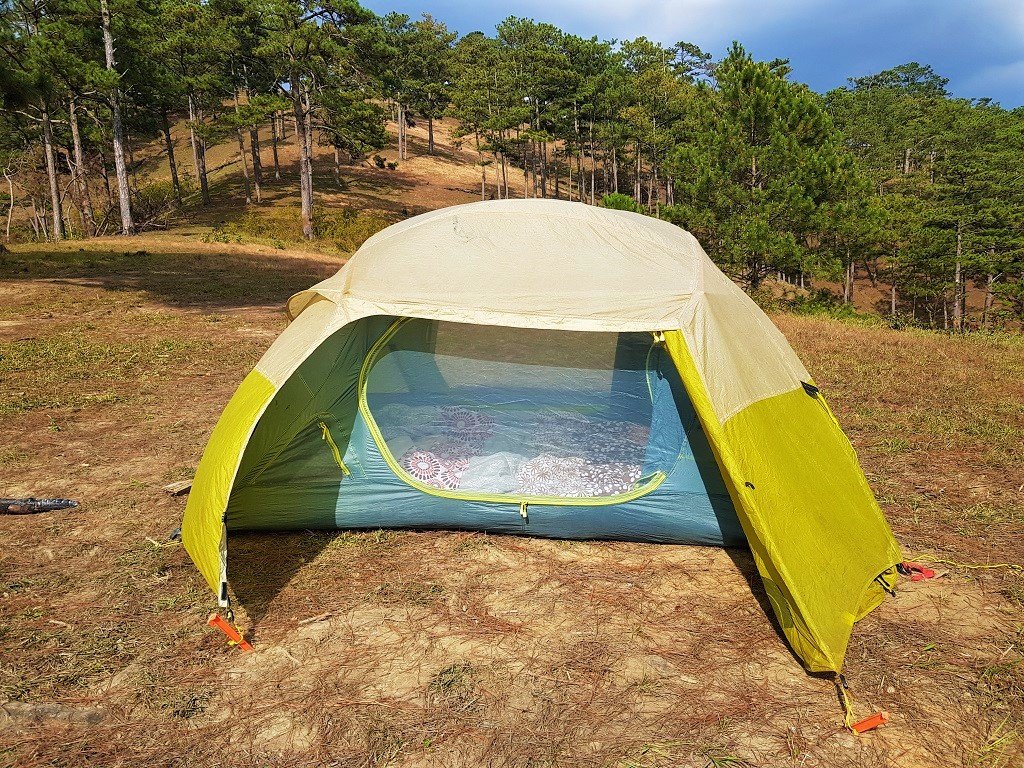
Because this is ‘wild’ camping, you’ll need your own tent & other camping equipment
What kind of tent you choose is up to you. But standard dome tents with a fly sheet should be fine. You want something light weight and compact so that it’s easy to carry on your bike. But you also need a tent with a decent fly sheet to keep the cold out at night (remember, it does get cold at night) or, if you’re camping between April-October, to keep the rain out. Some people also like camping hammocks; I don’t especially like them, but they’re available from stores in Vietnam if you want.

Tents are available to buy in most large Vietnamese cities & also sometimes for rent
Although technically it’s not absolutely necessary, you should bring a small camp stove (or two) for cooking. (The alternatives being cooking directly over a campfire or bringing pre-cooked food with you). [See Food & Drink]. For the camp stove (or camp fire), you’ll need a lighter or matches and/or fire lighters – you can buy the latter in stores: ask for cồn khô. Other necessities include a torch (flashlight), warm clothing and a sleeping bag or thick blanket (again, it can get cold at night). Having something to sleep on is also a good idea: the ground can be cold, hard and uneven, so having something soft and insulating between you and it makes the difference between a comfortable night and a sleepless one. Eating utensils, such as spoons, chopsticks, and any tech gear, such as cell phones, power banks, are good to remember too.
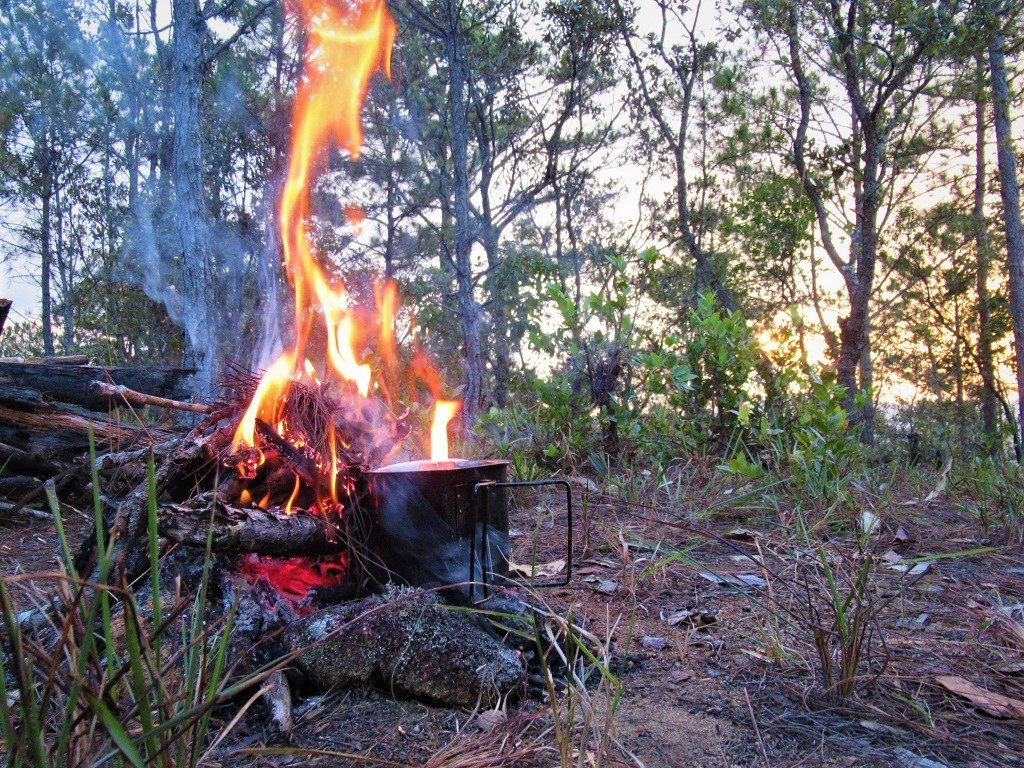
Bring a camp stove & utensils & make sure you have enough clothes & bedding to stay warm at night
Most importantly, bring something to put your rubbish in. Sadly, many domestic travellers neglect to do this: set an example by making sure you leave your campsite exactly as you found it. For peace of mind, it’s good to have a lock or chain for your bike so that you can secure the wheels and leave it near your tent during the night (see Safety). Other little things which I’ve found useful over the years are socks (great for wearing outside the tent on the forest floor), wet wipes (great for cleaning your skin and cooking utensils), candles (very comforting at night, especially if you don’t want to make a campfire), mosquito coil (long-burning and effective), thermos bottles (great for storing hot water so that you don’t have to reheat heat it every time you want a coffee or noodles), a portable musical instrument, such as a guitar or ukulele, and a decent knife.
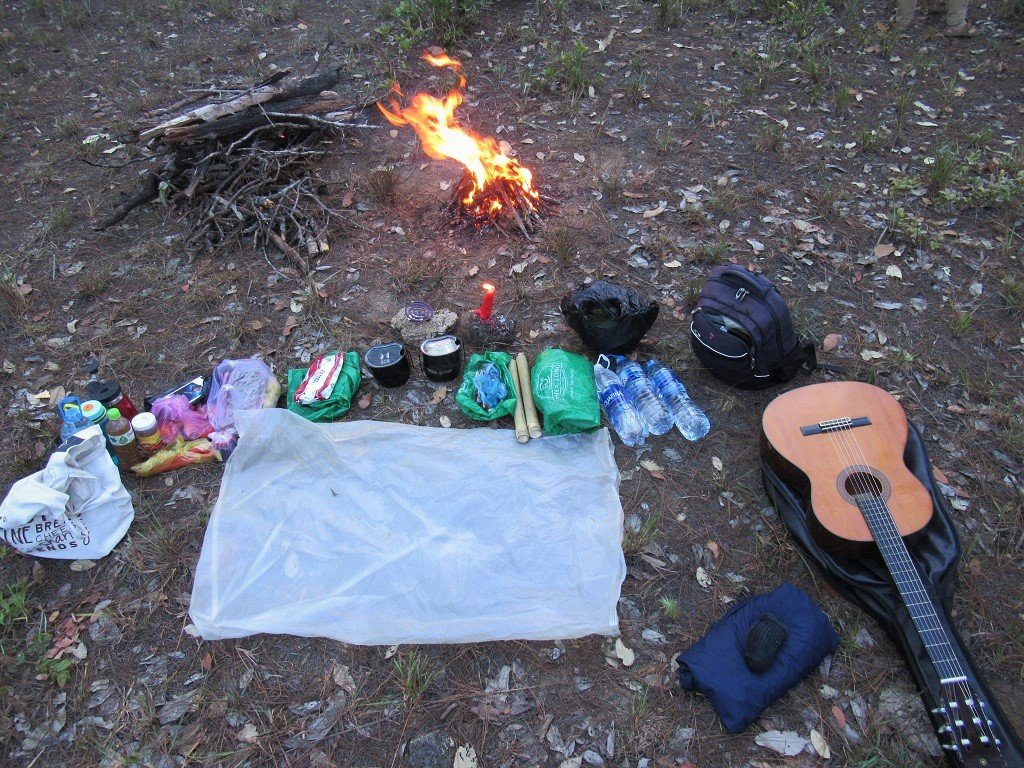
Little extras, such as candles, a thermos, mosquito coils etc make all the difference
What About Food, Drink & Toilets?
Obviously, there are lots of shops in Dalat city where you can get all necessary food and drink supplies from. But there are also a few local shops, restaurants and villages dotted around the pine forests north of Dalat. However, once you’re in the pine forests proper, there’s hardly anything at all, save for a handful of wooden cabins belonging to local farmers. If you intend to camp for a night or more, the most important thing to bring is water. You can buy 1.5 litre bottles of drinking water pretty much anywhere in Vietnam. But, for camping, a better idea is to find a shop selling big 5-6 litre bottles of water (look around Dalat and you’ll find them fairly easily). Strap a 5-6 litre bottle on the back of your bike in addition to carrying a couple of 1.5 litre bottles. This should be enough water for 2 people camping for one day/night, or even two nights if you use it sparingly. It’s surprising how much water you use: making coffee or tea, cleaning utensils, making noodles, brushing your teeth, and of course drinking. What’s more, the pine forests are quite dry: there aren’t many rivers and streams running through them, although it is possible to find a few waterways if you do some exploring.
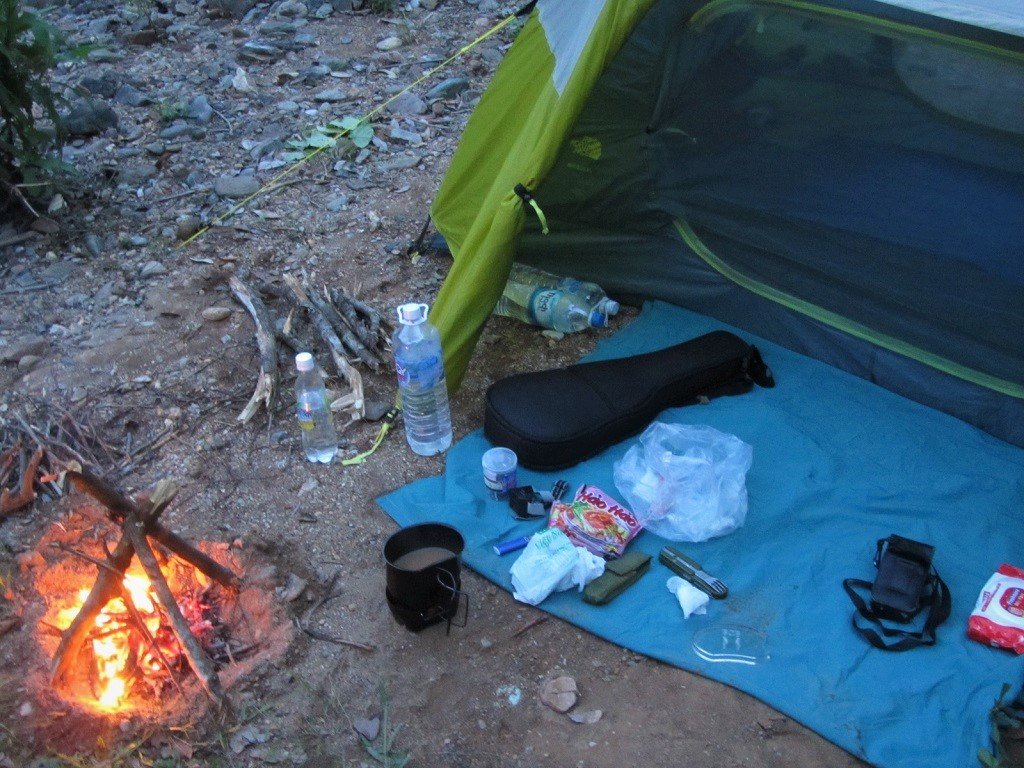
Supplies can be bought in Dalat & several villages: water is the most important thing to bring
As for other food and drink supplies, that will depend on whether or not you have a camping stove or cooking pot (which I highly recommend you do). If so, you can be as creative as you like with your camping food. My camping staples are usually packs of instant noodles, cans of tuna, nuts, fruit, chocolate, tea and coffee. You can also bring along garnishes, such as herbs (there are dozens of varieties available in Vietnamese markets and they’re very cheap) and a small bottle of soy sauce (nước tương), fish sauce (nước mắm) or five spice (ngũ vị) to liven things up. Tea and coffee are both grown locally and can be bought in Dalat. I carry a portable coffee maker (either a V60 dripper or AeroPress) so that I can brew good, real cups of coffee while camping, rather than instant coffee.
 With a bit of thought, camping food can be quite appetizing: this is instant noodles with fresh herbs
With a bit of thought, camping food can be quite appetizing: this is instant noodles with fresh herbs
A special highlands treat is cơm lam – sticky rice cooked inside a length of bamboo. You can find this in several roadside eateries on your way to the pine forests. You can buy cơm lam cooked or uncooked – if you buy it uncooked it’s a lot of fun heating it up on the campfire at night. Another local speciality is delicious whole, spit-roasted chicken (gà nướng), which you could buy to take away. (For cơm lam and gà nướng I recommend stopping by Quán Thung Lũng Xanh for excellent quality.) Dalat is also famous for its strawberries, which you can buy from several roadside gardens, such as My Tien Strawberry Farm.

Local delicacies make excellent camping food: bamboo sticky rice (cơm lam) & roast chicken (gà nướng)
Lastly, bring a bottle of something to really drink. Beer, wine and spirits are all available in Dalat. But I prefer to get a bottle of the local mountain brew to keep me warm and jolly at night under the stars. Rice wine (rượu) is very popular in the highlands. In particular, there’s a variety made from the fruit of the sim plant (rose myrtle) which grows up here in the highlands. The liquor is flowery, fruity and strong. Ask around or look out for signs by the roadside saying rượu sim – again, Quán Thung Lũng Xanh sells its own brew to take away.

Hot, local coffee on a cold highlands morning. Another local drink to try is rose myrtle liquor (rượu sim)
When you put all this together it can turn into some very pleasant dining experiences. For example, my friends and I have enjoyed piping hot noodles with chunks of tuna, crunchy peanuts, fresh, aromatic herbs and spicy sauce on cold, dark nights in the forests; or shots of rose myrtle liquor around a fire while dipping fresh strawberries into a pot of melted chocolate; or greeting the misty, rose-coloured dawn from inside our tent with a hot cup of fresh, locally grown, arabica coffee.
As for toilets, do as the animals do and go in the forests: there are trees, leaves, ditches and dykes. But do it sensibly: dig a hole and cover it up when you’re done.

With a campfire, stove & a bit of imagination, food & drink while camping can be appetizing & satisfying
When is the Best Time of Year to Camp?
By far the best time of year to camp in the pine forests north of Dalat is from November to March: the height of the Southern Dry Season. During this time of year, the weather is perfect for camping: dry, warm, sunny and bright during the daytime, but cool (sometimes cold) during the nights and early mornings. It’s worth noting that, although daytime temperatures are usually between 20-30°C, at night they can drop to single digits Celsius: the coldest I’ve experience while camping here in the dry season is 7°C. Needless to say, if you don’t have at least a sweatshirt, jeans and a sleeping bag, it can be very unpleasant sleeping in these temperatures. In the dry season, the days are bright and glorious, the nights clear with many stars, and the early mornings are misty and damp with dew. During the rest of the year (April to October) there’s always a chance that rain will spoil the fun. Up here in the mountains (over 1,500m [5,000ft]) the weather changes quickly: even on sunny summer days, the clouds can roll in and the rains can fall steadily for hours. If camping at this time of year, come prepared for wet conditions. It’s wise to check the weather forecast for the next 24 hours before you decide to camp: I use the rain/thunder satellite on Windy.com.

The Southern Dry Season (November-March) is ideal for camping: dry, warm & sunny with cool nights
Is it Safe to Camp?
I’ve camped in the pine forests north of Dalat dozens of times over the last 10 years and I’ve never had a bad experience. On one occasion, my friend and I were forced to abandon our campsite in the early evening, because it had rained steadily for five hours and we’d carelessly pitched our tents at the foot of a hill, so the rains ran down and flooded our campsite. I was once disturbed (and terrified) during the night when I heard heavy footsteps approaching my tent and saw two giant shadows moving outside, only to discover that they were a couple of beautiful buffalo. I’ve never been told not to camp and I’ve never had a problem with local authorities: one time, a forestry worker walked by my campsite, I asked his permission to camp, and he said it was fine as long as I did so responsibly. (See also How to Choose a Campsite.) When you go to sleep, make sure you have all your most valuable possessions with you inside the tent, and don’t leave food out during the night. In general, if you come prepared and use your common sense, you should be fine.
*WARNING: It should go without saying that if you make a campfire you need to be extremely careful, especially in the dry season, because pine is very flammable & the forests can be very arid at certain times of year: fire can spread quickly & easily. Be sensible, keep your fire small & under control & don’t take anything for granted.
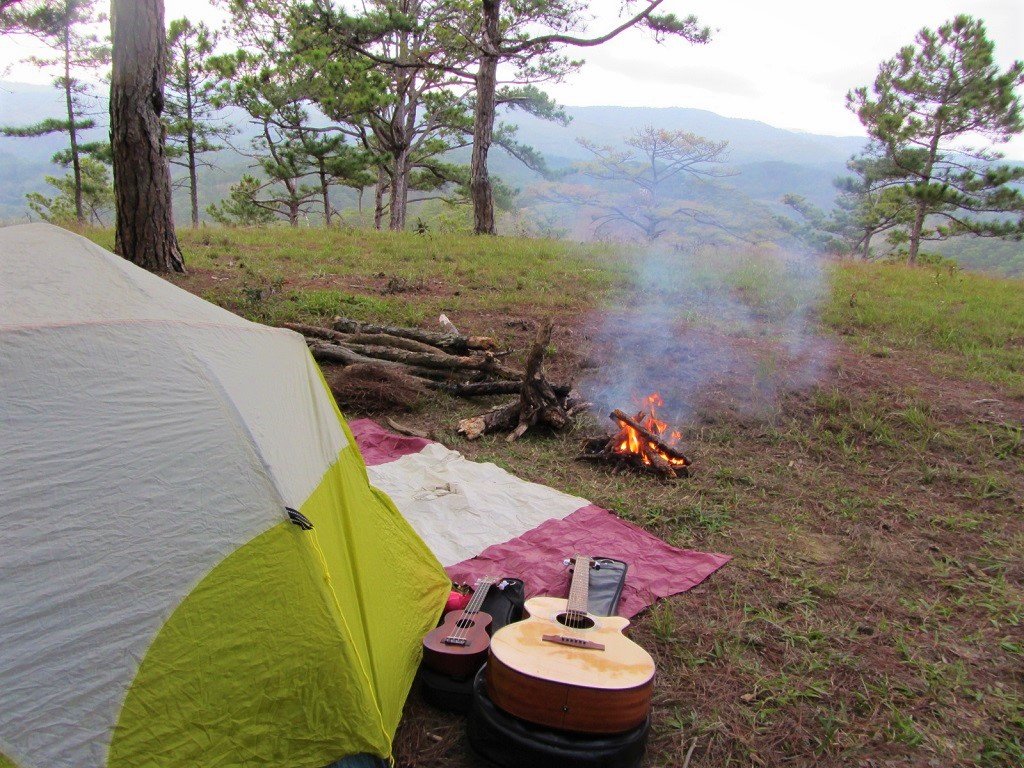
I’ve never had any security issues while camping in the pine forests of Dalat for a decade
Most of the big animals and predators that used to roam these forests – tigers, elephants, bears – are now long gone; hunted and poached to death. Nonetheless, nighttime can still be a scary, sobering experience: the darkness belongs to animals, not humans. You get a real sense of this as you lie in your tent, listening to the chorus of animals and insects outside in the big, black landscape. Don’t leave food outside your tent at night: clean your utensils, stash your food in a container, and tie up your litter in a bag. Snakes and mosquitoes are probably the most dangerous animals you’re likely to encounter, neither of which like fire. Snakes, apparently, don’t like heavy footfall and are unlikely seek out a place of human actively. (I’ve seen many snakes in Vietnam, but none when I’ve camped.) For mosquitoes, burn a coil throughout the evening and night, and bring bug spray if you need it. (See also Equipment.) In the night, there are occasional howlings, animal calls, rustling in the trees and brush, and, sometimes, what sound like gunshots. These could potentially be poachers prowling the forests at night, but I think it’s more likely to be some sort of crop protection device that sounds whenever an animal comes close to a farmer’s field. Other sounds you might hear at night include chainsaws and axes: illegal logging and poaching are big issues in Vietnam.
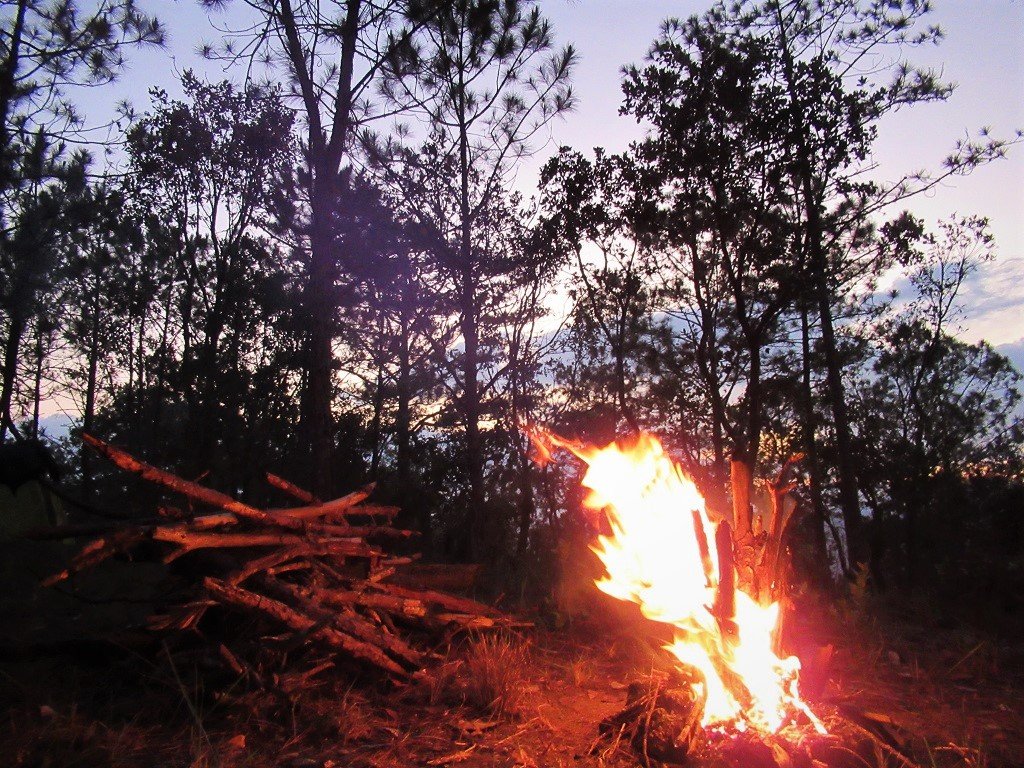
The nights can feel scary, but large predators are long gone from these forests
I lock the wheel of my bike at night (although it would be almost impossible to steal it without being woken). I also leave my bike facing in the direction of ‘escape’, if for some reason I need to make a quick exit during the night (bad weather, perhaps, or some unforeseen circumstance). If you do need to bail out in the middle of the night, Dalat is generally only a 45-60 minute ride away. Other safety precautions include, keeping your bearings, making sure you have a flashlight (and spare batteries), a USB battery pack to charge your phone, and a knife. All of which you should keep easily within your reach while in your tent at night. But mostly it’s about using your common sense and keeping your wits about you.
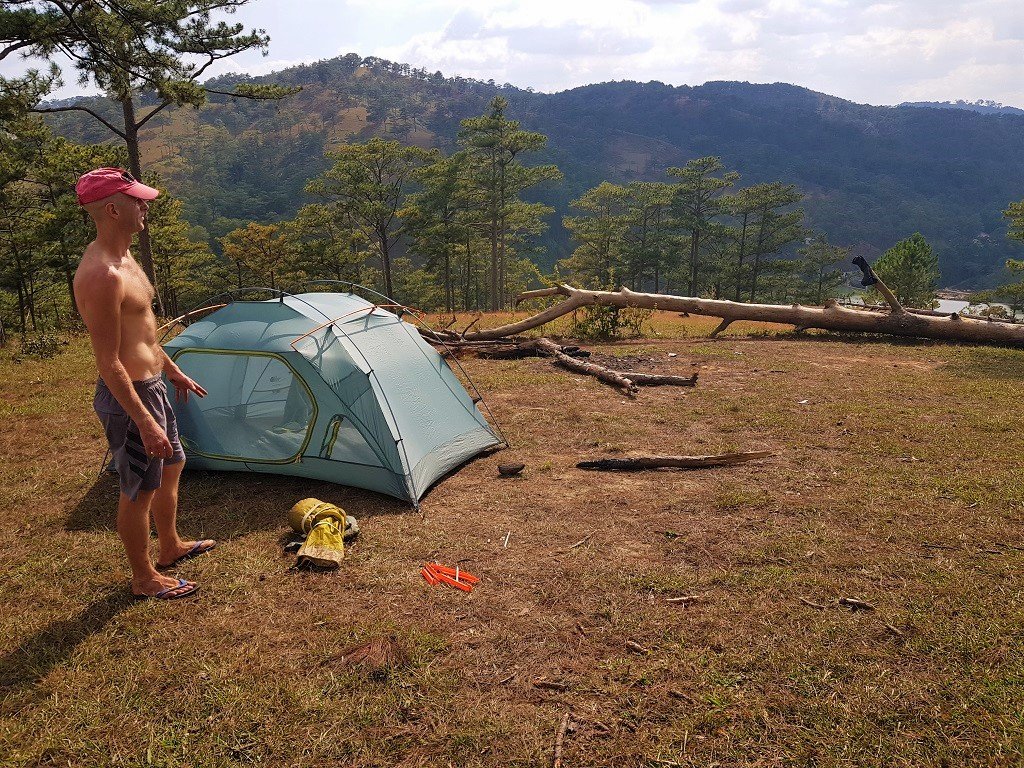
Make sure you have a phone & power bank, a flashlight, a knife & know how to get back to the main road
Image Gallery: Camping in Dalat
Below is a gallery of 50 images of my experiences camping in the pine forests north of Dalat over several years. Click any image to expand, and press back to return to the gallery:

Around the campfire 
Home in the pine forests 
Fire starter 
Under the canopy of pines 
Sunset in the pine forests 
Making camp 
Cooking dinner 
Dawn from the tent 
Songs around the campfire 
Dinner: noodles & herbs 
Fire at night 
Getting ready to cook 
Supplies & dinner preparation 
Motorbike & tent 
Bamboo sticky rice (cơm lam) 
The endless pine forests of Dalat 
A day under the trees 
Tending to the campfire 
Dirt tracks into the forests 
Sunrise over misty mountains 
Camping on a mountaintop 
Collecting firewood 
Into the clouds 
Transportation & accommodation 
Riding into the pines on dirt tracks 
Alone in the woods 
Morning coffee 
Camping under the pines 
A cold & misty dawn 
Sunset through the pine trees 
A clear day in the forests 
Wood smoke & string instruments 
A tent for all seasons 
Friends & fire 
Hanging out on the ‘porch’ 
Sunset from the campsite 
Stocky up on firewood 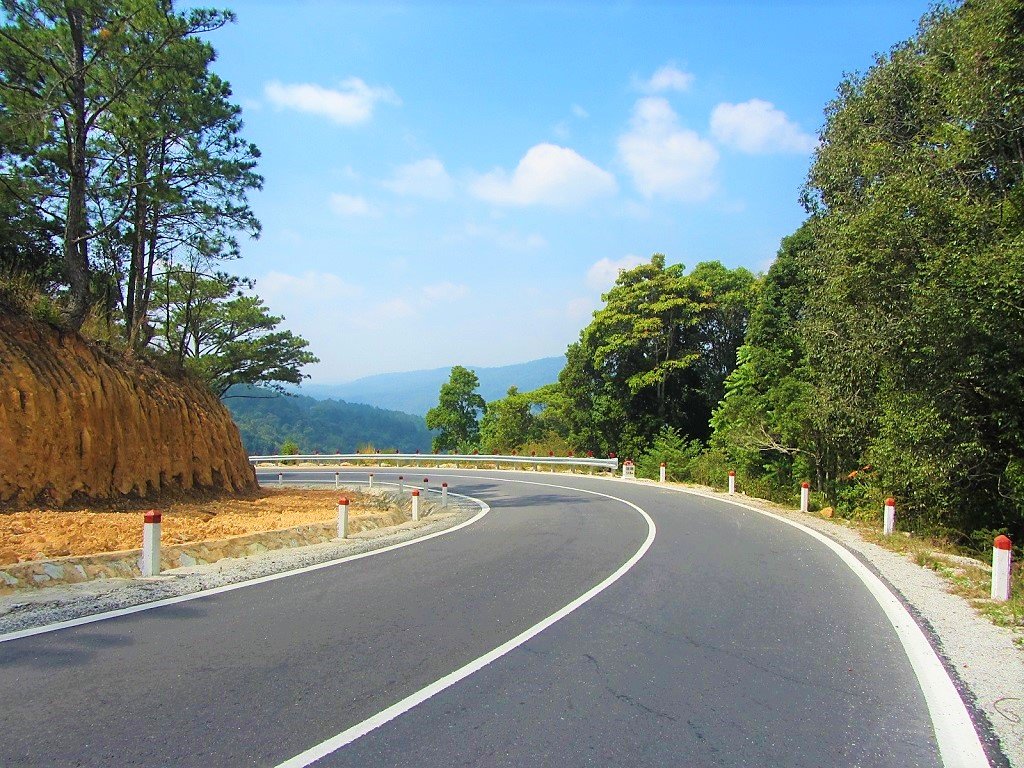
The Pine Tree Road 
Escape into the pine forests 
A good campsite 
Ukulele & coffee to greet the dawn 
Watch the sun go down 
Dusk over the purple ridges 
A chilly evening in the forests 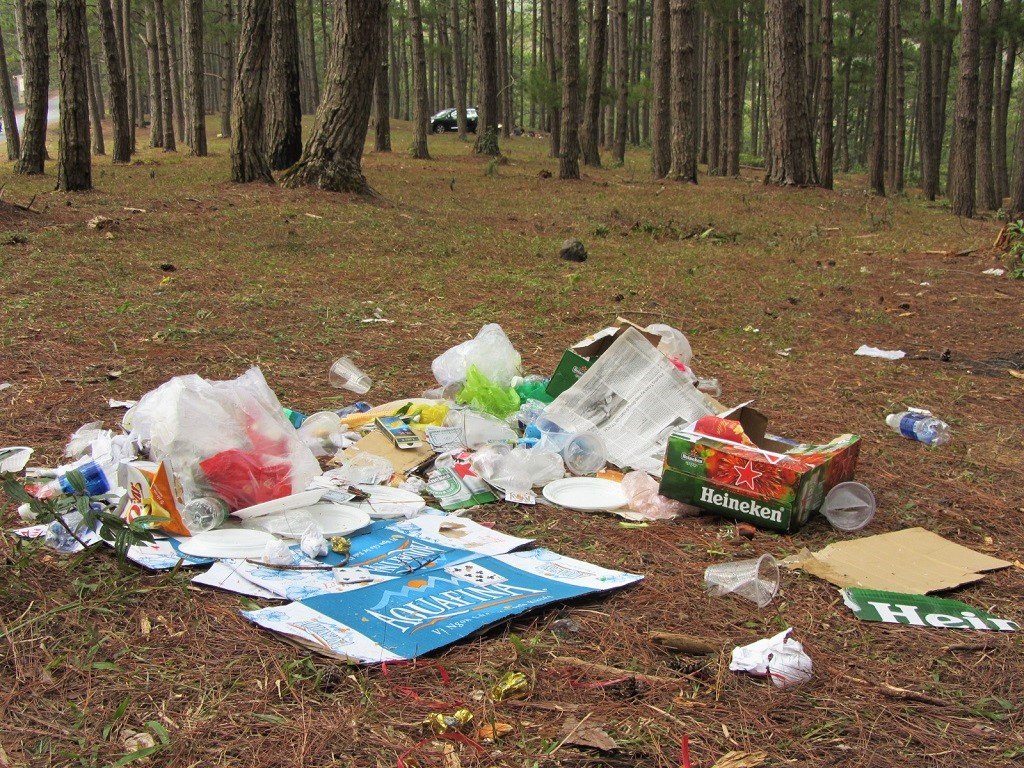
Trash left by picnickers in the forests 
Sunset on a hillside 
Camping alone in the forest
Disclosure: I never receive payment for anything I write: my content is always free & independent. I’ve written this guide because I want to: I enjoy camping in this area & I want my readers to know about it. For more details, see my Disclosure & Disclaimer statements here
[Back Top]
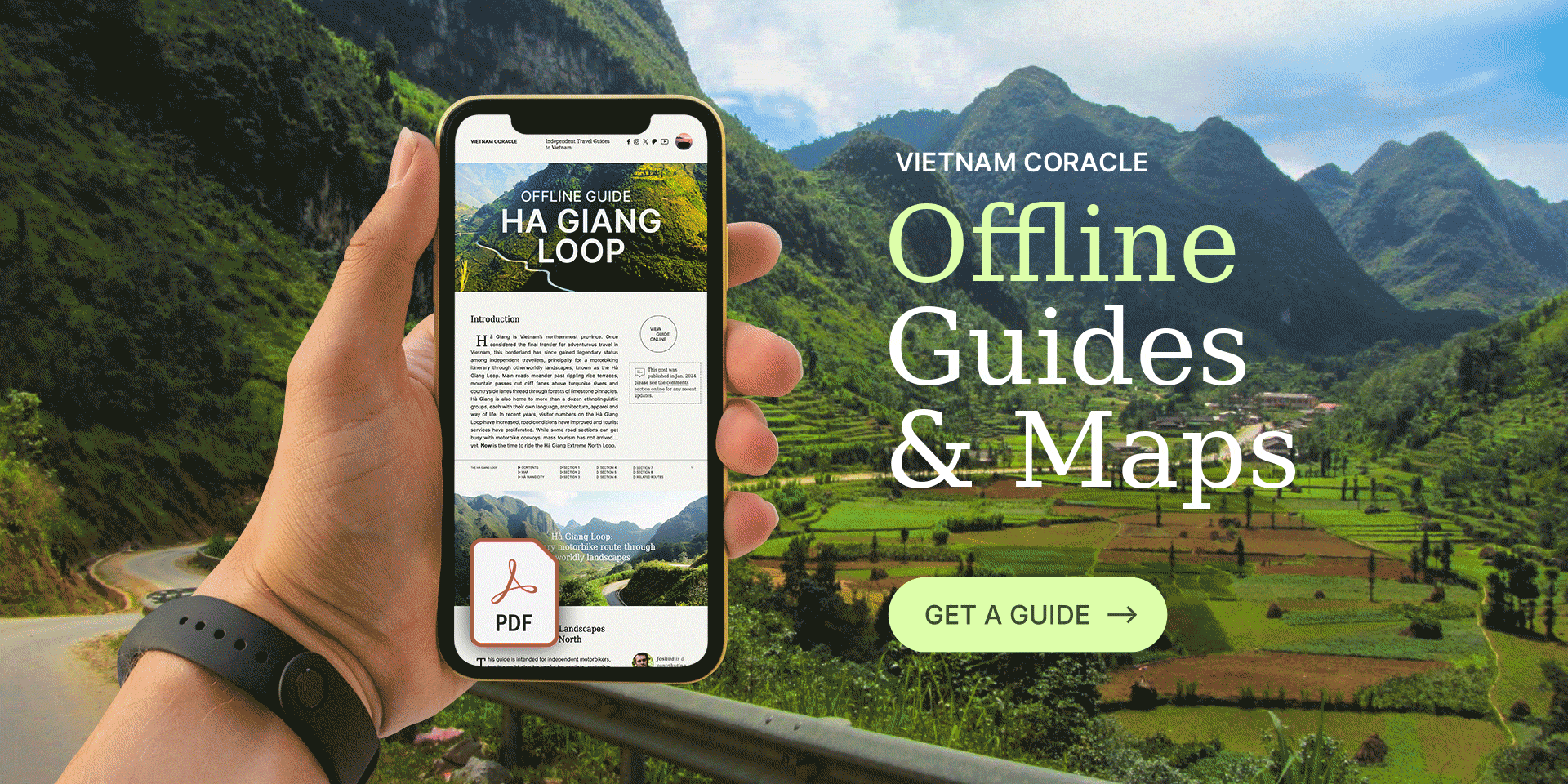
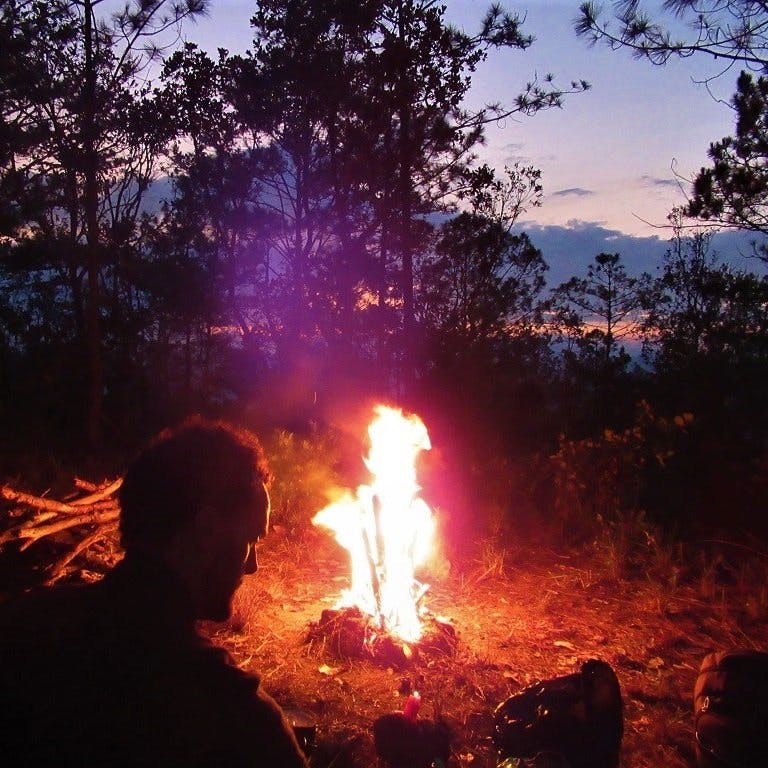
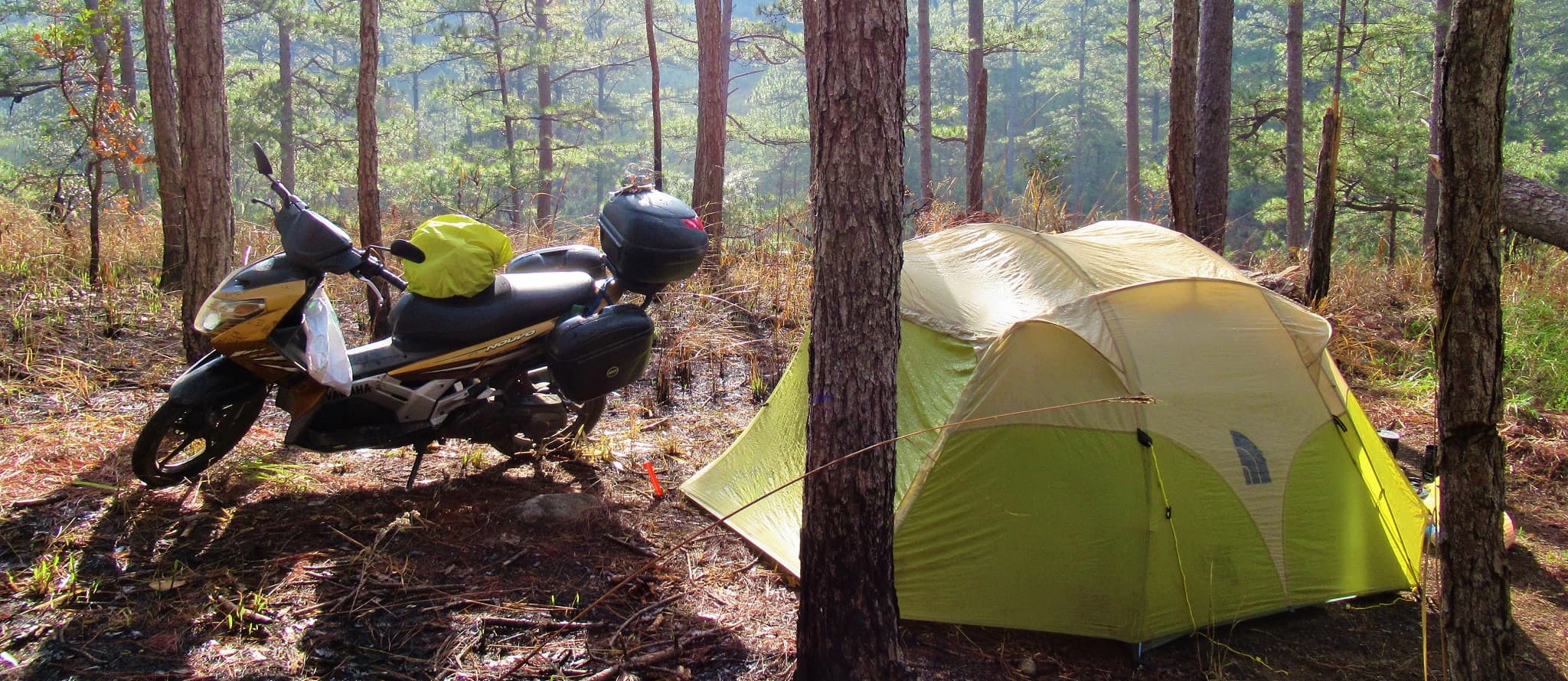
Hi Tom, I’ve just stumbled across your site so interested to read about wild camping in Vietnam – having just returned from a month cycling in Kyrgyzstan I’m now looking for my next cycling adventure.
Have restrictions changed a lot in the last year or so? Being on a push bike as opposed to a motorcycle it’s so much harder to be told to pack up in the middle of the night and find somewhere else if an official or local says you can’t stay!
Now I’ve found your site I’ll read on but wanted to now if any cyclists had experienced it getting more difficult to camp as it becomes more popular and sadly the litter problem escalates!
Many thanks
Justin
Hi Justin,
Camping in Vietnam should be fine of a bicycle – just follow the same general etiquette and cautions as I have described in my camping guides. Camping is still a very popular activity among young Vietnamese. If you browse and read through my Camping Archive, you will begin to get a sense of how to go about doing it in Vietnam.
Best,
Tom
Hi Tom,
My girlfriend and I followed your advice and we had a great experience. It was my girlfriend’s first time camping and she really enjoyed herself. Great weather and great location (we went north of Suối Vàng). Didnt run into any issues at all, quiet place with a great view. Even lucked out with a full moon night for a nice view at night.
Thanks again:)
Blake and Hiền
Hi Blake & Hiền,
It’s really great to hear that, thanks.
You’re lucky to have a full moon – especially on a clear night.
I hope you both have many more positive camping experiences in Vietnam in the future.
Best,
Tom
Hi Tom,
Things have changed a bit these days because of Covid. A friend and I were hassled for wild camping just on the edge of a National Park along 28B south of the dam (~11.532309, 108.346637) without registering with the local police. First a couple locals, then the same locals left and returned with a cop, then the cop left and returned with his boss. They kept saying we might be transporting Covid. We managed to convince them we lived locally (driver’s licenses) and that the ride out would be treacherous fully loaded in the dark down a hill that’s gnarly in the daylight. The cop was back at 6 a.m. to make sure we left as promised.
We’ve both camped in the same spot many times before without incident. Would be interested to hear if anyone else has had a similar experience.
Cheers.
Hi John,
Thanks for sharing. Sorry to hear about that. Actually, I would also expect a bit more suspicion of campers etc this year because of Covid, but I had another couple of readers follow this guide and camp in Dalat recently and they had a great time without any issues.
Either way, whenever or wherever you camp in Vietnam, it’s always best to be as discreet as possible, and if someone sees you, ask permission.
I hope you get another chance to camp again soon.
Tom
Do you know much about the legality (and the “legality”) of camping in VN? Most of the issues I’ve run into in the south-central highlands revolve around being out and about (even with proper paperwork) in the forest and staying in places I shouldn’t be staying.
Hi Sara,
Border areas are particularly sensitive, for obvious reasons. But apart from that, I’ve never encountered problems with local officials. If and when I come across an official, I ask permission to camp, and I’ve not been refused so far. I don’t know about the legality of camping in the wild in Vietnam – but it sounds like no one else does either: my Vietnamese friends are under the impression that it’s allowed as long as it’s not in politically sensitive areas or on private land. Either way, wild camping is still unusual in Vietnam, so it’s best to be as discreet as possible, and if people do see you camping just politely ask if it’s OK to camp there or not.
I hope this helps,
Tom
Hi Tom,
Great that you’ve posted about camping up there. We didn’t have enough time at hand last time we visited Dalat with my friend, but we did look around searching for ideal spots. I remember telling my friend about one of your earlier posts when we stopped exactly in the same area that you are introducing in this post, and we thought it was very ideal for camping. I even told my friend that you must’ve been writing about that part of the highlands just North of Dalat, and now it indeed turns out to be the case. 🙂
I’ll read this post more thoroughly, and in the meantime I wonder what you think about going there this time of the year. I’ve never been up in Dalat in the rainy season.
Thanks,
Gábor
Hi Gábor,
Thanks, I’m glad you like it.
Yes, I think it’s still worth going up to Dalat, even in the rainy season, to camp. It doesn’t rain ALL the time, and more often than not it’s slow, steady rain, rather than the tropical downpours you get along the coast. However, you should definitely make sure you have a good, waterproof tent.
I hope you enjoy it,
Tom
Hi Tom,
The tent is a pretty solid Jack Wolfskin. That should do the job. Thanks for your words of encouragement.
Best,
Gábor
Great!
Hey Tom,
First off great site, well designed and very informative. My girlfriend and I are traveling SE asia and are getting ready to motorbike Vietnam from Saigon to Hanoi. We both love camping and have been trying to find reliable information on camping during our ride. Here is my question, we didn’t pack and camping supplies and we are on a budget, we would love to camp but want to know if there is enough camping opportunities along our ride to make it worthwhile buying a tent and a little stove?
Any advise is welcome, Thanks.
Roy
Hi Roy,
It depends on which route you take really. Camping is increasingly popular in Vietnam, and many cool campsites have sprung up over the last few years. But these are concentrated in certain areas – see my guide to Camping the Ocean Road for example.
There are more opportunities for ‘wild camping’ on the mountain roads than on the coast roads. This is mainly because the coast is more built-up and developed than the mountains. On stretches of mountain roads, such as the Western Ho Chi Minh Road from Khe Sanh to Phong Nha, there are lots of great places to pitch your tent for a night. However, you should always be careful when ‘wild camping’ in Vietnam: it’s not very common so you may attract attention and possibly suspicion, so make sure you are as discreet as possible and that your campsite can not be seen from the road. Also, don’t just wander off into the jungle.
Another thing to consider is time – if you have plenty of it, then I think it’s definitely worth bringing your equipment along with you and trying to camping as often as possible. But if your time is limited, it’s probably not worth it.
Remember, you can almost always find decent budget accommodation wherever you are in Vietnam at nhà nghỉ which are local guesthouse – more about that here.
I hope this helps,
Tom
Hi Tom,
I am on a bicycle trip around SE Asia, just arrived in Vietnam and plan to bike from Saigon to Hanoi. I know it might not be the best season, but I want to do a bit of camping. Do you know where to buy fuel for my camping stove in Saigon? And the name of it? So far I havn´t found any. I have a Trangia, but lost my fuelbottel.
Hi Sara,
Try at one of the places I mention in my Camping the Ocean Road guide here. You’ll find links to two places in Saigon under ‘About Camping on This Route’. Fanfan and Leu Du Lich are their names. You could also try U Best on Bui Vien Street.
Camping is not so bad at this time of year – it’s kind of between seasons at the moment, so you should get plenty of sunshine and rain 🙂
I hope you find it.
Tom
Hi Tom
Thanks for your reply. I already went to Fan Fan, but they didn´t know about it. I will have a look at the other shops. Thanks for sharing all the cool stuff here!
/Sara
Hi Sara,
I hope you find it. Camping in Vietnam can be a lot of fun – even if it rains 🙂
Enjoy!
Tom
Hi Tom,
My boyfriend and I are flying into Da Lat and out of Nha Trang and want to do the motorbike ride from one to the other. Do you know anywhere in Da Lat that offers one-way motorbike rental? Any advice you have would be much appreciated!
Thanks 🙂
Rica
Hi Rica,
I don’t know of a specific place that hires bikes one-way but I don’t think it will be difficult to find because this is quite a popular one-way ride to do. Just ask at your guesthouse or hotel in Dalat.
I hope this helps,
Tom
Thanks for getting back to me so quickly Tom. I’ll let you know if we find a particularly good company to with :).
Rica
Hi Tom,
I found your blog at the right time. This is an amazing blog. Thank you for your time and effort to put all the info for fellow travellers and inspiring others is the most important thing in life. So I said I found you at the right time. I’ll be backpacking in Vietnam for 3 weeks starting from 26th January 2016. I am a solo female traveler and I wanna do a motorcycle trip from Ho Chi Minh to Hanoi. My questions are: 1-) what do you think about doing solo motorbike trip and camping as a solo female traveller? 2-) have you seen any dangers that I should absolutely avoid? 3-) do you know any local contacts in Vietnam to help me buy a motorbike? 4-) i have never driven a motorbike accept a scooter, so which type of motorbike should I get? 5-) before starting the journey what info I should learn about motorbikes as a must? 6-) do you know a local school that I can volunteer for couple of days and help them to raise funds? I am not interested in big NGOs as they are already well-known but small ones and local schools need exposure to get volunteers and funds, if you knew and could share, I would appreciate so much. I am looking forward to hearing from you. Thank you so much.
Hi Evrim,
Firstly, I don’t think that travelling in Vietnam as a solo female is any
more dangerous than it is in any other Southeast Asian nation: just take
all the normal precautions you would when travelling solo in any other
country. Vietnamese people as generally very kind and friendly, and this is
even more so in off the beaten track locations. In fact, the places where
you should be most careful and the more touristy towns, such as Nha Trang
and Ho Chi Minh City in the Pham Ngu Lao ‘backpacker’ area.
For buying a motorbike you can look at the noticeboards in backpacker
hostels, cafes, bars and hang outs in Saigon or Hanoi. Also you can join
the Expats Ho Chi Minh City Facebook page because bikes are often for sale
on it. You can also contact Tigit Motorbikes to see if they have one to
sell – you can mention Vietnam Coracle if you like, they know me. Or you
can rent a bike which can be more convenient: I recommend Rent a Bike
Vietnam: you’ll find an ad for them in the right sidebar of any Vietnam
Coracle page.
If you haven’t ridden much before, then I suggest you get an automatic bike
rather than a manual or semi-automatic. Good automatic bikes include the
Yamaha Nouvo (like mine here) and the Honda Air Blade.
They are easy to drive, reliable and perfect for any of the road trip that
I have written about. But they are more expensive than other bikes.
You don’t really need any specific knowledge of bikes before you go. There
are local garages everywhere: just write the word sửa xe máy and you will
always find someone to fix your bike. Even in remote areas, if something
happens just find the nearest person or house and they will help you.
I don’t know any specific schools but you could try contacting the Noble
Foundation in Saigon and asking them if they can recommend somewhere.
I hope this helps,
Tom
Hi Tom,
Thanks a lot for your reply. I’m looking forward to enjoying this wonderful place. I’ll let you know later about my experience.
Take care,
Lisandro.
Hi Tom,
Thanks a lot for the information you shared with us. It’s very helpful for everyone, especially for those who want to go a bit further in travelling and not just staying on the beaten track.
I’ve been living in Vietnam for more than two years in Binh Duong New City, I teach English at a university here. It’s a very nice place to live.
As I have a short holiday, I decided to go to DaLat for 4 days, arriving on Friday 18th early morning, at abut 5:30 am and leaving for Saigon on Monday 21st at night. I’m planning to go camping, so I’m going well equipped. I’m taking with me a tent\hammock\sleeping bag and cooking gear.
I did some research about were to go and I came across your blog. I want to visit some waterfalls and camp there as I go, I was wondering if that is possible. I’d like to avoid guest houses or hostels where possible. I also want to camp in the pine forest you posted, it looks great. Did you leave your motorbike next to your tent?
My idea is to rent a motorbike as soon as I get there and return it before I leave, so any info about renting bikes will also be appreciated.
Thanks for your help,
Lisandro.
Hi Lisandro,
Yes, camping in Dalat should be possible and nice at this time of year. However, because you are going to be there on a weekend some places may be a little busy. For example, the waterfalls can be crowded on weekends.
The pine forests where I camped are great. Yes, I parked my motorbike next to my tent at night. But I made sure the bike was locked and secure and that it was visible from my tent. I can’t recommend anywhere specifically to rent motorbikes in Dalat, but I’m sure it will be easy to find one, especially in the backpacker area around Truong Cong Dinh Street.
At some of the waterfalls it is possible to camp – empty ones like Bo Bla and Gougar are OK. You can ask to camp at Pongour. And there are good pine forests around Tiger falls and Bao Dai falls.
In general, pine forests around Dalat are great for camping, but try to be as invisible as possible – obviously a foreigner camping in the forest will attract attention – and you don’t want that when you’re camping. When camping at the waterfalls, it’s best to ask permission from some one first – often they will agree.
I hope you have a great trip,
Tom
Hi Tom,
Thanks for your answer, I did some research and this shop look great to get what we need for the trip. We are use to camp on our travel here in France, always leave the place as clean as we found it. I heard it can get pretty difficult to camp on someone land in Vietnam, we are more thinking about only camping on the beach or in forest along the Laos border.
Thanks again for your work on this blog.
Yann & Amanda
Hi Tom,
I’m Yann, my girlfriend Amanda and I are coming to vietnam in January and we want to travel from Saigon to Hanoi on motorbikes.
We wanted to thank you for the effort you put into this blog, it as been very helpful for planning our trip. We decided to follow your tracks from Saigon and head to Hué, then climb up in the mountain.
We just wanted to now if you have any recommendations of where we could find camping gear (tent, sleaping bags…) in Saigon, and if it is easy to find camping spots along the way?
Looking forward to hearing from you,
Yann & Amanda
Hi Yann and Amanda,
In Saigon you can find some camping equipment around the backpacker area of Pham Ngu Lao in District 1. There’s a store called Fan Fan at 61/4 Co Giang Street, you can email them: fanfanvn@gmail.com
Camping in Vietnam is good fun, but you should choose your site carefully. It’s best if you are not visible from the road. And, of course, make sure you camp responsibly: don’t leave any trash and don’t camp on some one’s land unless you get permission from them first.
Remember it can get quite cold and raining in January in places north of Nha Trang, like Hue.
Have a good trip.
Tom